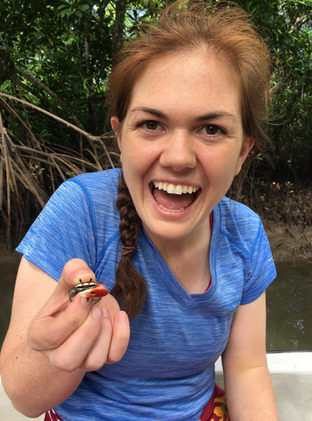
Lauren is conducting a research project that investigates the community health of mangrove-dependent fisheries across a gradient of anthropogenic pressures in the Republic of Fiji. She aims to determine if the degree of anthropogenic pressure will affect the availability of habitat for species of fish and invertebrates, correlate with species richness in mangrove ecosystems and correlate with quality of fish health.
Lauren is also one of SCB’s 2017 Graduate Student Research Fellowship award winners. This award supports field work, including travel, materials or equipment, required to conduct research by graduate student members.
It is thanks to our members that SCB can support students doing such important work to advance the science and practice of conserving Earth’s biodiversity.
SCB held a Q&A with Lauren to learn more about her research and her time in the field in Fiji!
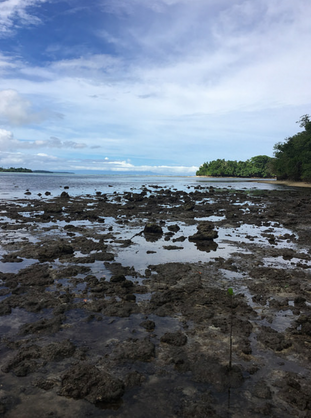
What have been your biggest challenges in this research project?
Well, getting there proved to be a challenge in itself! I had quite the travel adventures. For the actual project, I think some of the biggest challenges were trying to efficiently operate on “Fiji time” when trying to get permits or samples, and to be able to adapt to what resources were available to us in the field. For example, about halfway through the project our equipment for measuring pH, temperature and salinity broke, and as that isn’t something that is readily available at the local store we ended up only getting that data for two of our four sites. We also ended up trying to figure out how to do chemistry on a boat in a storm to get water quality measurements -that was fun! As for working on “Fiji time,” there were some days in the village that I had intended to spend going out fishing with the women, but we would have arrived on the village clean-up day, or on a day when a local NGO was conducting microfinance workshops, etc. So just little things like that, that are hard to predict!
What is your favorite part about conducting your research in Fiji?
Definitely the people. Everyone is so incredibly warm and welcoming, and willing to share their knowledge and culture with you. The connection that many Fijians have with the sea, for either their livelihoods or for general enjoyment, is really special and interesting to learn about and experience. And the weather and general natural beauty that comes with working in an island paradise isn’t bad either!
What surprised you the most?
I was surprised at how rarely things go the way you expect them to! We had to start adapting to changes in our schedule right from the start, which was challenging but also fun and bonding for our group.
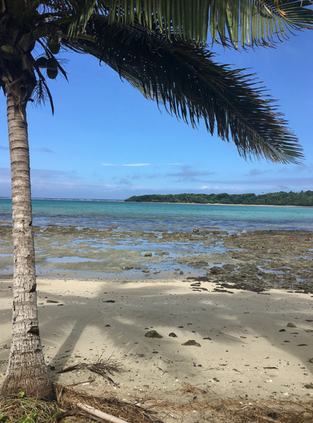
What does a typical research/work day look like for you in Fiji?
It really depends on the day! When we were in Suva, we would often start the day early and walk across town to the open-air cafeteria to eat breakfast and read the news. Then we would grab our field bags and head down to the water to collect water samples or crabs, or head to the local fish market to talk with fishermen/women about their catch and try to bargain for a few fish to take back. When we were in the village our schedule very much depended on their schedule. We would usually spend the day either in the village interviewing people, or we would be out with them on the boat or walking through the mangroves. The evenings in the village would consist of lots of story-telling and traditional kava drinking, and lots of people throughout the community would gather together until late in the night.
What comes next? What do you hope this study results in?
I am hoping that this project serves to create a dialogue between local resource users and decision-makers. By assessing the current state of human influence on the environment, we are hoping the information can be used to inform both future development decisions as well as mitigation plans for already highly impacted areas.
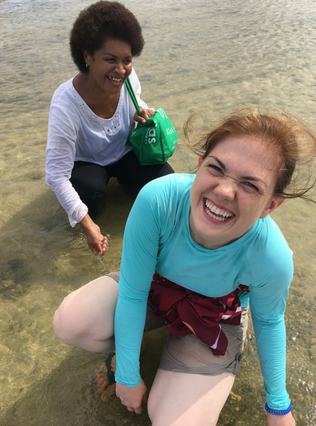
Tell us a brief version of your favorite story from Fiji.
As part of our study, we had been collecting fish specimens from local markets at each of the sites we visited. One day one of our team members, Sefa Sakai, thought we should try to catch a few on our own and offered to teach me how to fish. He had me grab an old bottle, wrap some fishing line around the top and then attach a piece of lead to the end of the line. Then we walked down to the water and waded out to some rocks to cast our lines. He demonstrated the correct way to cast first, and then let me try my hand. It took several attempts for me to get even close to accurate, but he was very patient. At one point I apparently got a little too excited, and ended up throwing my whole body weight into my cast and fell right off the rock! Sefa tried to control his laughter, the rest of my lab not so much! We had a great time, and I can now say that I know how to fish like a local! Although I’m definitely not as good, and never did end up catching anything!
Where could we find you on any given Saturday? What do you like to do for fun?
Depends on the Saturday! Very few of them are the same. When I’m not working I really enjoy traveling, exploring new things and places, and spending time with my friends and family. Living in NYC has given me the chance to explore some really incredible museums, and has allowed me to learn about other disciplines like art and history, which has been really fun! It’s a nice mental break, and lets me venture out from my own little world of marine science and expand my thinking, which has often resulted in me taking new perspectives back to my work! I also really love to hike and run, which helps to keep me balanced and escape from city life.
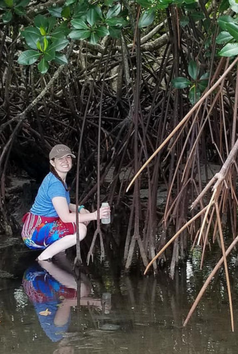
What are three things you always carry with you when in the field?
My advisor introduced me to a “field proof” notebook and pencil, which I now love and carry with me for every excursion. It’s waterproof, so it even came in handy during a couple of SCUBA dives! Second would probably be sunscreen, because for me it is an absolute necessity, especially when working in the tropics! And third is a bit of a personal quirk. I have a little park ranger key chain that my college roommate gave me years ago. It looks a bit like me, so my friends named her “Little Lauren” and we pass her around each time one of us leaves the country. So every time I leave for field work, she comes too, clipped onto my backpack!
Why did you decide to study conservation biology? What was your path that led you here?
I have always wanted to be a scientist, in some form or fashion. I grew up loving animals and nature, and even dressed as Steve Irwin for Halloween in 3rd grade. So oddly enough, I’ve never really deviated from wanting to do what I’m doing now! That interest has certainly grown and changed in shape, but the core is the same. Over time I started to recognize how complicated the connections between humans and nature really were, and I wanted to better understand those interactions and try to problem-solve to figure out how to support healthy human populations while also conserving healthy natural areas and species.
What do you love most about what you do?
I love most everything about what I do! I love that I have been given the chance to work on projects that I am passionate about, and to seek solutions to the problems that challenge me. I know that not everyone is given that chance, and I feel very blessed to have had the opportunities and incredible support system that I did. I feel like in this field I have the opportunity to make a difference for the world, and to serve and take part in the global community. I love that I get to be part of something that is bigger than me. That I can stare out at the ocean while I’m out collecting data and just think “Wow, that’s big!” and there are so many questions that we are just starting to find answers to. This work is constantly changing, and it keeps me on my toes!
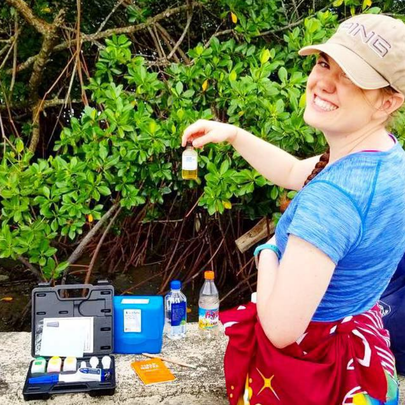
Who’s the scientist you admire the most? Why?
I admire a lot of scientists, but I have a special appreciation for Dr. Sylvia Earle. She is incredibly well-spoken, brilliant, and inspiring. She has had an amazing and diverse career, and has forged new paths in ocean science. She is a role model for all, but I have found her particularly inspiring as a woman in science. She has shown me what can be done, and that pushes me to do more. She is also a visible spokesperson for the issues she passionate about, and has taken up the banner of science communication to both spread awareness and inspire hope. And that is really important to me, because I feel like her message of hope is much needed. When facing such seemingly insurmountable obstacles, hope helps to push us forward and makes us believe that more than be done, that there are solutions to every challenge, and we just have to try harder and think smarter to find them!
How did you choose to do this research project in particular?
I first chose Fiji because I wanted to ensure that whatever knowledge I gained from this project could be returned to the communities. This was especially important to me given the fast pace of a Master’s program, where typically only one full field season is had before completion of the thesis. My lab has longstanding ties with the communities in Fiji, as my advisor has worked on various projects in the country for over a decade, so I felt confident that my goal of communicating results could be achieved.
I was interested in this project in particular because Fiji has a strong history of reliance on traditional fisheries, as these fisheries serve as both a form of food security as well as an important source of income. Fiji also has a thriving tourist industry, and is experiencing a migration of its native population to urban coastal areas. Given that both tourism and fisheries are important to the Fijian economy and are predominately located along the coast, I wanted to understand how coastal fisheries were faring under increasing anthropogenic pressure. This relates back to my interest in understanding the impacts that humans are having on the environment, and how we can most effectively and efficiently manage our footprint on our oceans in particular.